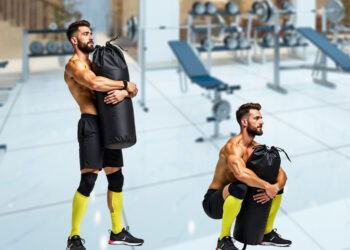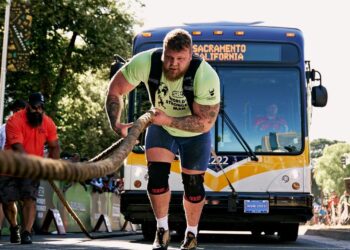When it comes to building bigger, stronger legs, squats are most people’s go-to exercise. And while we love squats, they aren’t without disadvantages. For a start, you really need to do them in a squat rack if you are lifting heavy weights, and that’s not always possible or practical, especially if you work out at home.
Also, squats are a bilateral or two-legged exercise. That means you might be pushing harder with one leg than the other. That could affect your physique and your sporting performance.
The good news is that there is a brilliant exercise you can do instead that addresses these shortcomings.
That exercise is split squats.
We’re not saying you have to give up squats – that would be sacrilegious – but you can use this exercise to plug the developmental gaps that squats can leave.
How to perform split squats
Split squats are a very effective lower body exercise, but only if you do them right! Follow these steps to make sure that every rep you perform is as productive and safe as possible.
Level Up Your Fitness: Join our 💪 strong community in Fitness Volt Newsletter. Get daily inspiration, expert-backed workouts, nutrition tips, the latest in strength sports, and the support you need to reach your goals. Subscribe for free!
How to do it:
- Stand with your feet together and your arms by your sides. Look straight ahead and stand up tall in good posture.
- Take a large step forward and then stop.
- With your abs braced and your torso upright, bend your legs and lower your rearmost knee down to within an inch of the floor. Your front shin should be close to vertical and your leading knee behind your toes.
- You should feel that about 70% of your weight is on your front leg.
- Without moving your feet, stand back up, pause, and then descend again.
- Keep going until you have completed the prescribed number of reps.
- On completion, either step forward or backward to bring your feet back together.
- Rest a moment and then repeat on the opposite leg.
Muscles Worked
Split squats are a compound exercise, which means it involves two or more joints and multiple muscle groups. This move is best thought of as a total lower body exercise. That said, the main muscles you use during split squats are:
- Quadriceps – quads for short, these are the muscle on the front of your thigh, which are responsible for knee extension.
- Hamstrings – located on the back of your thigh, the hamstrings flex your knee and extend your hip.
- Gluteus maximus – also known as your glutes and basically your butt, this is your main and most powerful hip extender.
- Abductors* – the muscles on the outside of your hip, which are responsible for hip abduction or moving your leg away from the midline of your body.
- Adductors* – the muscles on the inside of your thigh, which are responsible for hip adduction or moving your leg in toward the midline of your body.
Split squat variations
Basic split squats are a beneficial exercise, but if that’s the only variation you do, your workouts will soon become boring and unproductive. Here are the best split squat variations to try.
1. Bulgarian split squats
This variation increases the range of motion at your hips and knees to produce a much more challenging workout.
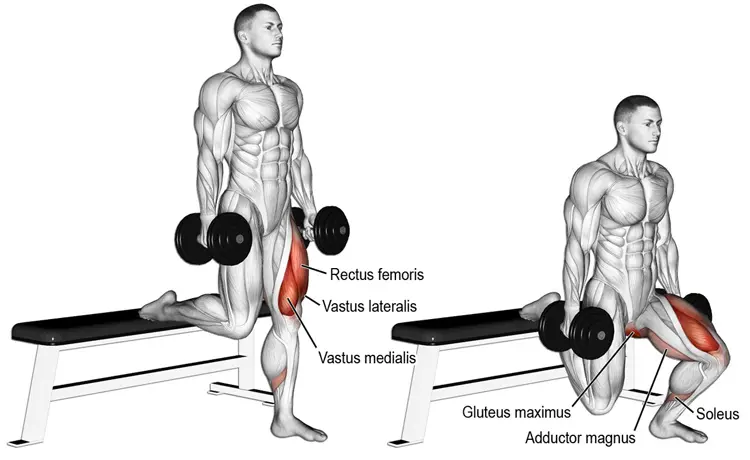
How to do it:
- Stand with your back to a knee-high bench
- Bend one leg and place your foot on the bench behind you
- Hop forward into a split stance
- Keeping your torso upright, bend your legs and lower your rear knee down to within a few inches of the floor.
- Stand back up and repeat.
2. Smith machine split squats
Using a Smith machine means you can load your muscles with more weight while making balance much less of an issue. This is a good exercise for building leg size.
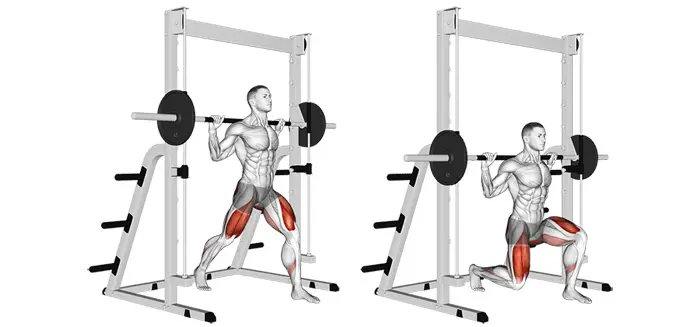
How to do it:
- Duck under the Smith machine barbell and rest and hold it across your upper back. Stand with your feet together, and your core braced.
- Move your front foot forward and your rear leg back so you are in a split stance. The weight should be directly over your hips.
- Bend both legs and lower your rear knee down to just above the floor. Keep your front shin vertical and your knee behind your toes.
- Stand back up and repeat.
- Rest a moment and then do the same number of reps on the opposite leg.
3. Split squat jumps
This exercise will increase lower body power. It’s a high impact move that’s best left to more advanced exercisers. But, if you play sports, this could be a good move for increasing your jumping and running abilities.
How to do it:
- Step out and into a split stance. Bend your legs and lower your rear knee down toward the floor.
- Using your arms for extra momentum, jump up and into the air.
- Land with your knees slightly bent and then descend into another rep.
- Continue for the prescribed number of reps.
- Rest a moment and then repeat on the opposite side.
- You can also do this exercise using an alternating leg action, swapping legs in midair before you land.
4. Barbell split squats
Using a barbell is much more challenging than bodyweight and dumbbell split squats because you won’t be able to use your hands for balance. Also, as your center of gravity is higher, you may find that you wobble a little more too. But, if you have mastered bodyweight, Smith machine, and dumbbell split squats, doing them with a barbell is the next logical progression.
How to do it:
- Rest and hold a barbell across your upper back.
- Perform your reps as normal.
- Rest a moment, change legs, and repeat.
5. Deficit split squats
With regular split squats, your range of motion is limited by your knee touching the floor. Using a small step creates a deficit that means you can move through a larger range of motion, making this exercise much more demanding.
How to do it:
- Place your front foot on a low, stable platform such as an aerobic step box top, or a couple of stacked bumper plates. Step back and into your usual split squat stance.
- Perform your reps as normal.
- Rest a moment, change legs, and repeat.
Benefits of split squats
Split squats offer several significant benefits and advantages. The main ones are:
1 – Identify and fix left-to-right strength imbalances: Most people have one leg stronger than the other. But, if you have too much of a strength imbalance, it can cause problems. Big strength imbalances can lead to postural abnormalities and even injuries. Doing this exercise will highlight any irregularities and also allow you to fix them.
2 – improve your balance: Good balance is essential in sports and everyday life. If you have poor balance, you are more likely to fall over. The extended stance and narrow foot alignment mean that split squats are an excellent way to build better balance.
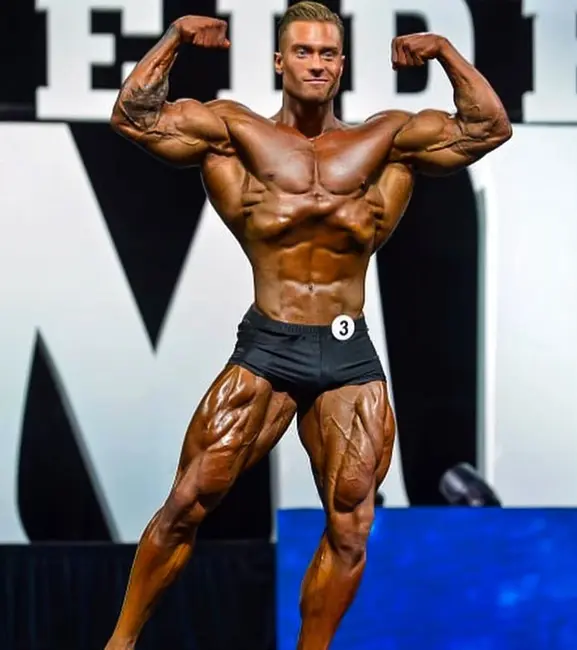
3 – better sports performance: Split squats work the same muscles used in running and sprinting. Including split squats in your sports training workouts should lead to better performance.
Level Up Your Fitness: Join our 💪 strong community in Fitness Volt Newsletter. Get daily inspiration, expert-backed workouts, nutrition tips, the latest in strength sports, and the support you need to reach your goals. Subscribe for free!
4 – easy on your knees: Lunges and split squats work the same muscles. However, when you do forward lunges, you put a lot of stress on your front knee. Because split squats are more stationary, there is much less knee stress. With less movement going on, it’s also easier to make sure you’re your front shin is vertical, and your knee is well behind your toes.
5 – good for hip mobility: Split squats involve a large range of motion at your hip joints. As well as strengthening your muscles, it also provides them with a worthwhile stretch. This can help loosen your hips and increase mobility. Good hip mobility is important for posture and sports performance.
Important split squat performance tips
Get the most from this exercise by implementing the following split squat tips!
Do the same number of reps on each leg– unless you have one leg much stronger or bigger than the other, make sure you do the same number of reps on each side.
However, if you have one leg that is weaker or smaller than the other, do that leg first and then, after a rest, do the same number of reps with your more muscular leg. This will help balance your strength and muscular development.
Use a wall for balance– if you have good balance, you should be able to do this exercise without additional support. But, if you find that you wobble around a lot, you may not be ready to do this exercise unaided. If you need some extra help, do this exercise side on to a wall and use it for balance. Move away from the wall as your balance improves.
Use dumbbells for a more challenging workout– if you’ve mastered the bodyweight version of this exercise, make it harder by holding a dumbbell in each hand. Keep your arms straight and down by your side to avoid compromising your balance.
Move slowly and deliberately– this exercise works best with a slow and deliberate tempo. If you go too fast, you may lose your balance and won’t keep your muscles under tension for long enough for the exercise to be beneficial.
Try a 2-1-2-1 tempo, which means descend in two seconds, pause for one second, ascend in two seconds, and pause for one second. With each rep taking six seconds, you should soon feel your leg muscles starting to work.
Stretch your hips before doing this exercise– split squats are a tough exercise that is even tougher if you have tight hips. Make sure you stretch your hips before attempting this exercise. One easy way to do this is to step out into a lunge and lower your rear knee down to the floor. Rest here for 30 seconds and then swap legs.
Common Mistakes
Reduce your risk of injuries and get more form this exercise by avoiding these common mistakes.
Going too deep too soon– if you’ve got tight hips, lowering your rear knee down too close to the floor could overstretch your muscles and could even cause injury. Let your hip mobility guide you and only descend as far as you feel comfortable. Your range of motion should improve with practice, and if your hips are very tight, doing some extra stretching will also help.
Keeping your back leg straight– some people try to do this exercise with a very straight back leg. Don’t be one of them! A straight back leg increases the angle of hip extension and places a lot of extra stress on the hip joint and muscles. Instead, bend the back leg to around 90 degrees to make this exercise safer but no less effective.
Letting the knee travel forward of the toes– the further forward your knee travels during split squats, the more stress you put on your knee joint. Keep your front shin as vertical as you can. Stand side-on to a mirror to check that you aren’t letting your front knee move too far forward.
Using too much weight– while split squats are a compound exercise like regular squats, they are not really suitable for lifting heavy weights. The narrow but long stance makes balancing tricky, and if you wobble, a heavy weight could result in injury. Use lighter weights and higher reps – 8-15 per leg – to get all the benefits this exercise has to offer with fewer risks.
Wrapping Up
Bilateral or two-limbed exercises like squats and leg presses are good for building muscle and strength, but they have drawbacks too. That’s why almost every exerciser should also include a few unilateral or single-leg exercises in their workouts.
Split squats are easy to learn, require no special equipment, and are a great supplement to two-limbed leg exercises. Add them to your workout to make sure both of your legs are equally strong and muscular.





